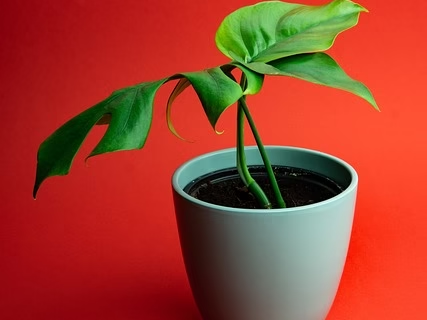The Monstera Deliciosa, commonly known as the Swiss Cheese Plant, is a stunning tropical houseplant prized for its large, glossy leaves with natural splits and holes (called fenestrations). With the right care, this plant can grow vigorously, making it a favorite among indoor gardeners.
This comprehensive Monstera Deliciosa care guide covers everything from light and watering needs to troubleshooting common problems, ensuring your plant thrives year-round.
Table of Contents
1. Light Requirements for Monstera Deliciosa Care
Monstera Deliciosa thrives in bright, indirect light, mimicking its natural rainforest habitat where it grows under tree canopies.
- Ideal Placement: Near an east or north-facing window where it receives gentle morning or filtered sunlight.
- Avoid Direct Sunlight: Harsh afternoon sun can scorch the leaves, causing brown patches.
- Low Light Tolerance: While it can survive in lower light, growth will slow, and leaves may develop fewer fenestrations.
- Signs of Poor Lighting:
- Leggy stems (stretching toward light)
- Small leaves without splits
- Slow growth
For optimal growth, rotate the plant occasionally to ensure even light exposure.

2. Watering Your Monstera Deliciosa Correctly
Overwatering is the most common cause of Monstera Deliciosa problems, leading to root rot.
- When to Water: Check the top 2 inches of soil—water only when dry.
- Watering Frequency: Typically every 1-2 weeks in summer, less in winter.
- Proper Drainage: Use a pot with drainage holes and well-draining soil to prevent waterlogging.
- Signs of Overwatering:
- Yellowing leaves
- Mushy stems
- Foul-smelling soil
- Signs of Underwatering:
- Drooping leaves
- Dry, crispy leaf edges
Use room-temperature water to avoid shocking the roots.
3. Humidity & Temperature Preferences
Native to tropical rainforests, Monstera Deliciosa loves high humidity and warm temperatures.
- Optimal Humidity: 60-80% (use a humidifier, pebble tray, or mist leaves occasionally).
- Temperature Range: 65°F–85°F (18°C–30°C)—avoid cold drafts or sudden temperature drops.
- Winter Care: Reduce watering and keep away from heaters to prevent drying out.
Low humidity can cause brown leaf tips, while cold stress may lead to blackened leaves.



Top On Sale Product Recommendations!
5 in 1 Air Quality Monitor, TVOC HCHO, Temperature Humidity, CO2 Meter, USB Rechargeable, CO2 Detector, Black
Price Now: USD 11.13 (Original price: USD 14.46, 23% off)
Click & Buy
4. Soil & Fertilizer for Healthy Growth
Monstera deliciosa care involves using the right soil mix, which ensures adequate aeration and helps prevent root rot. The right soil mix ensures proper aeration and prevents root rot.
- Best Soil Mix:
- 50% peat-based potting mix
- 30% perlite or pumice (for drainage)
- 20% orchid bark or coco coir (for aeration)
- Fertilizing Schedule:
- Spring & Summer: Feed every 4 weeks with a balanced liquid fertilizer (20-20-20).
- Fall & Winter: Reduce or stop fertilizing (plant is dormant).
- Signs of Nutrient Deficiency:
- Pale or yellow leaves (nitrogen deficiency)
- Slow growth (lack of phosphorus/potassium)
Avoid over-fertilizing, which can cause salt buildup and leaf burn.
5. Pruning & Support for Optimal Growth
Monstera Deliciosa care is a climbing plant that benefits from pruning and support.
- Pruning Tips:
- Trim yellow or damaged leaves to redirect energy to new growth.
- Cut back overgrown stems to maintain shape.
- Providing Support:
- Use a moss pole, trellis, or bamboo stake to encourage upward growth.
- Aerial roots will attach naturally, promoting larger leaves.
Regular pruning keeps the plant bushier and healthier.
6. Common Monstera Deliciosa Problems & Solutions
Yellow Leaves
- Cause: Overwatering, poor drainage, or nutrient deficiency.
- Fix: Check soil moisture, repot if needed, and adjust watering.
Brown Leaf Edges
- Cause: Low humidity, underwatering, or salt buildup.
- Fix: Increase humidity, water consistently, and flush soil occasionally.
No Fenestrations (Splits in Leaves)
- Cause: Insufficient light.
- Fix: Move to a brighter location (avoid direct sun).
Pests (Spider Mites, Mealybugs, Scale)
- Treatment: Wipe leaves with neem oil or insecticidal soap.
Root Rot
- Signs: Black, mushy roots, foul odor.
- Fix: Trim rotten roots, repot in fresh soil, and reduce watering.
7. How to Propagate Monstera Deliciosa
Monstera Deliciosa care is straightforward, and it can be easily propagated using stem cuttings.
Steps for Propagation in Water:
- Cut a healthy stem with at least one node (aerial root bumps).
- Place in a jar of room-temperature water.
- Change water weekly to prevent bacteria.
- Roots will develop in 2-4 weeks—transfer to soil when roots are 2-3 inches long.
Propagation in Soil:
- Plant the cutting directly in moist, well-draining soil.
- Keep humid (cover with a plastic bag for a greenhouse effect).
- New growth should appear in 4-6 weeks.
Final Monstera Deliciosa Care Tips
- Clean leaves monthly with a damp cloth to remove dust.
- Repot every 2-3 years to refresh soil and provide space.
- Rotate the plant occasionally for even growth.
By following this Monstera Deliciosa care guide, your Swiss Cheese Plant will grow larger, healthier leaves with beautiful fenestrations, making it a stunning centerpiece in any home.
